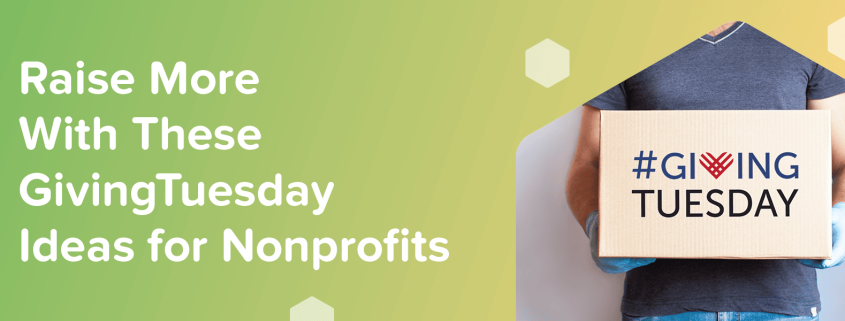Raise More With These 4 GivingTuesday Ideas for Nonprofits
It’s easy to get caught up in the hustle and bustle of the holiday season once fall rolls around. From holiday shopping to endless gatherings with friends and family, there always seems to be too much to do and not enough time to do it. However, the Tuesday after Thanksgiving is a holiday that encourages the world to pause and tap into the spirit of radical generosity.
Known as GivingTuesday, this international giving day began in 2012 as a simple way to kick off the holiday season, promote meaningful community engagement, and celebrate generosity in all its forms. Since its inception in 2012, Giving Tuesday has gained global awareness, raising more than $13 billion over the years.
GivingTuesday 2023 broke records for the Qgiv platform with a 13% increase in donation revenue compared to 2022 and a 25% increase in average donation amount. To keep this momentum going, nonprofits must develop a comprehensive GivingTuesday strategy.
Whether your organization celebrates GivingTuesday every year or you’re a new participant preparing for this year-end giving campaign, these fundraising ideas will encourage your supporters to contribute and maximize donation revenue.
1. Launch a text fundraising campaign.
With over 310 million smartphone users in the United States, your supporters are constantly on their phones, making text fundraising an extremely viable channel for your GivingTuesday campaign. Create urgency and make it easy for supporters to contribute to your campaign as soon as possible by reaching them on their most frequently used devices.
To get started with your text-to-give campaign, Bloomerang recommends following these steps:
- Choose a text-to-give provider. The right text-to-give software easily lets you launch this type of campaign. Look for a platform with features like a user-friendly interface, secure donation processing, and integrations with your other fundraising tools for the best results.
- Select an effective text keyword. Choose a keyword that’s short, easy to spell, and relevant to your campaign. For example, you may simply use “GivingTuesday 2024” as your keyword or something more specific to your organization like “Protect Wildlife.” Promote your keyword by displaying it on your website and social media channels.
- Develop a simple donation form. While you can direct donors to your regular donation page, consider creating a simpler, mobile-friendly donation page that makes the giving process more straightforward. Only collect the information you need, such as names, payment information, billing address, and contact information.
Make your texts more impactful by personalizing them to each recipient. Your text-to-give software should let you use automation to insert donors’ names to cater to each specific recipient. Additionally, leverage automated reminders to follow up with donors throughout the day, urging them to contribute before it’s too late.
2. Add a peer-to-peer fundraising element.
A peer-to-peer fundraising campaign is an excellent way to engage your supporters. By encouraging your donors, volunteers, and staff to reach out to their families and friends, you can tap into your community’s networks and raise even more for your cause. This type of campaign will introduce fresh faces to your nonprofit’s mission, and you can use the opportunity to nurture potential long-term relationships with a group of new donors.
Here are the steps for launching a successful peer-to-peer campaign:
- Set up a campaign website. The main hub of your peer-to-peer fundraising campaign should be an interactive, engaging web page. Make sure to use a peer-to-peer fundraising platform that makes it easy to set up branded fundraising pages and communicate with your fundraisers.
- Gamify your campaign. Introduce healthy competition to your peer-to-peer fundraiser to keep your donors engaged. Offer team-based fundraising options, add a fundraising thermometer to your website, launch challenges, and leverage leaderboards so donors can get excited about fundraising and track their progress throughout the campaign.
- Make social sharing easy. Qgiv’s peer-to-peer fundraising guide stresses the importance of social media for spreading the word about your campaign, stating that “The cascading effect can reach friends of friends, and that is the magic that is peer-to-peer fundraising.” Encourage your donors to share your event and their personal fundraising pages on social media. Place social sharing buttons on your campaign page so donors can promote their fundraising efforts to their networks of family and friends with just a couple of clicks.
Keep your peer-to-peer participants motivated by checking in with them throughout the day. Consider holding a virtual meeting halfway through the day where fundraisers across the globe can share their progress and exchange tips and tricks to power the rest of their GivingTuesday campaigns.
3. Host an event.
Host an event to celebrate GivingTuesday, offering your guests a memorable night that combines philanthropy and fun. This interactive experience can encourage donors to support your campaign and help you reach your fundraising goal.
Check out the following event ideas to find one that best suits your organization:
- Hold an auction. Auctions are enticing fundraising events because donors can win exciting items in exchange for their contributions. Make sure to procure a variety of items that will appeal to your supporter base and use dedicated auction software so the event runs smoothly.
- Plan a trivia night. Competitive donors will love the opportunity to show off their knowledge with a trivia night. Throw in a few facts about your organization and GivingTuesday to keep things relevant, and award a prize to whoever earns the most points.
- Throw a benefit concert. Live entertainment is almost always guaranteed to be a hit. Curate a unique lineup, securing local talent to perform at your concert. Livestream the concert for donors who can’t attend in person, and get creative with fundraising options. For example, offer song requests in exchange for donations, or allow your supporters the chance to win meet-and-greets with the performers after donating a certain amount.
- Organize a scavenger hunt. A scavenger hunt is a great event for people of all ages. Ask teams or individuals to donate to participate, and use the scavenger hunt to highlight locations that are special to your nonprofit or unique to your community. Sprinkle some trivia into your event to make it even more engaging.
- Hold a one-day in-kind donation drive. Rather than asking for monetary donations, your organization may host an in-kind donation drive. Publish your list of requested items in the weeks leading up to your event so participants can add supplies to their Black Friday and Cyber Monday shopping lists.
To expand your reach, consider offering virtual components to your events so supporters near and far can participate. The right event management software can not only power in-person, virtual, or hybrid events, but it can also streamline event communications and offer a more cohesive, engaging event experience.
4. Craft a social media campaign.
In the age of social media, connecting with your donors and creating a surge of public support only takes a few clicks. This is especially useful for time-sensitive, critical campaign days like GivingTuesday.
Here’s how to create an engaging social media campaign to promote your GivingTuesday fundraising efforts:
- Post regular updates. Use your social media accounts as a digital hub for your GivingTuesday fundraising efforts. Throughout the day of your campaign, post on social media to motivate supporters and keep them up to date on how your fundraising efforts are going.
- Use the GivingTuesday hashtag. When you tag your social media posts with #GivingTuesday, you make it easy for those who don’t follow your social media accounts to find your campaign and contribute. You can also scour the hashtag to get inspiration from what other organizations and their supporters are posting.
- Ensure your donation page is mobile-friendly. Since most of your supporters will access your social media posts on mobile devices, link to a mobile-friendly version of your donation page. Make sure the text and tap targets are large enough to read and touch on smaller devices, form fields are easy to click on, and all images are fully visible.
To make your social media campaign more compelling, consider reaching out to donors, volunteers, and beneficiaries to incorporate their stories. Storytelling can increase the authenticity of your content and inspire potential donors to give.
Once the clock strikes midnight and GivingTuesday is over, don’t forget about all the donors who made this successful day of giving possible. Use confirmation emails and receipts to express gratitude for your donors’ support.
Reiterate the positive impact donors made on your organization with their contributions. Then, offer ideas for how they can get further involved with your organization so you can build long-lasting relationships with these supporters.
Author: Megan Allison, Content Marketing Specialist at Qgiv

Megan has been a Content Marketing Specialist at Qgiv since 2022. She takes pride in helping nonprofits by creating content that shares fundraising tips and tricks, offers strategies for board development, donor acquisition and retention, marketing, and nonprofit management, and keeps organizations updated on the latest trends in the fundraising world. In her free time, Megan enjoys reading, music, and playing with her two cats.
